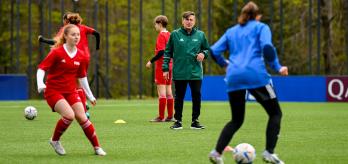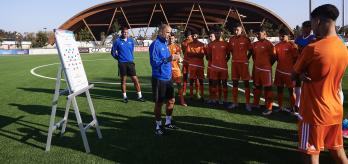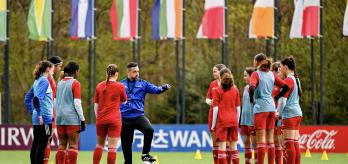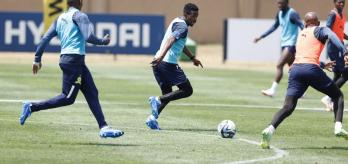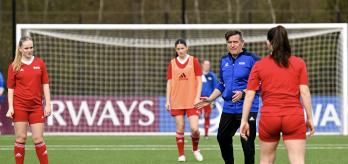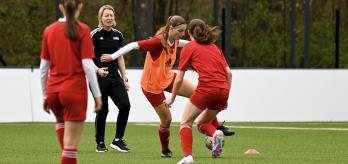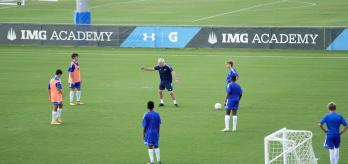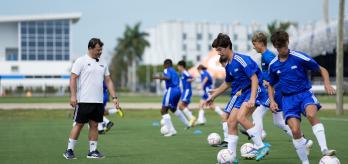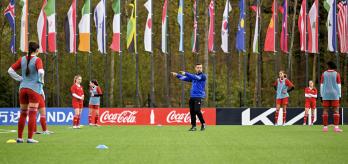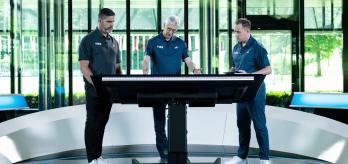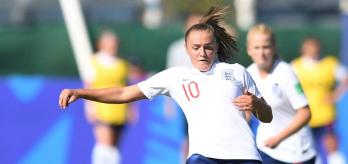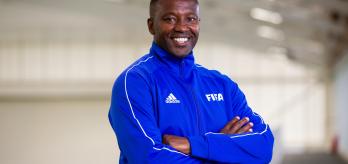By focusing on the movement and positioning of their team-mates and the opposition, as well as their own spatial awareness and body posture, attacking players can produce synchronised movements as a unit. To successfully synchronise attacking play across the front line, players should constantly scan the pitch, communicate with their team-mates, pay attention to the quality of the pass and drag the opposition out of position.
In this session, Michael Johnson, the ex-Derby County and Birmingham City defender and current England U-18 assistant coach, delivers a set of exercises based on attacking principles that help attacking players synchronise their movements and actions as a fully-functioning team.
The session begins with a small 4v4 drill that focuses on slight movements when in 1v1 situations and is followed up with a continuation exercise that brings wide players into play. The third exercise expands on these principles with a 6v5 (+goalkeeper) game, allowing players to focus on attacking within a 3+3 set-up. Finally, the session ends with an 11v11 game that brings all these aspects into play so that players can use them in a real game situation.
Session overview
This session involves varying numbers of players as it progresses. Therefore, it may be better to run the exercises in parts 1 and 2 in two groups simultaneously, using an additional coach. For part 3, the players may be split into two groups, with each group occupying its own side of the pitch.
-
Part 1: 4v4 – movement of the number 9 and the wide players
-
Part 2: 4v4 – movement of the number 9 and the wide players (wider pitch)
-
Part 3: phase of play 6v5+goalkeeper – movement in the front line
-
Part 4: 11v11 – creating space to attack
Key coaching points
-
Synchronised movements should be performed to open up spaces in the defence. For example, if the number 9 drops deep, the wide players should run into the space left behind.
-
Players should be encouraged to focus on maintaining a strong connection throughout the team by communicating and being aware of their team-mates’ positioning, as well as that of the opposition.
-
All players should be scanning the pitch and looking over their shoulders for areas of space to exploit, whilst also paying attention to their body positioning.
-
The quality of the pass is incredibly important and players should try to pass into the receiving player’s path of movement. It is also necessary to communicate where the pass needs to go.
This training session was designed to help players to improve their ability to work in synchronised motions as an attacking unit. The key questions are: how can players create space into which they can move? Where does the space open up when a team-mate moves into another area of the pitch?
Part 1: 4v4 – movement of the number 9 and the wide players
This exercise allows players to focus on attacking principles such as movement, scanning the pitch, spatial awareness and a player’s connection with the team when confronted with 1v1 situations. The players should be able to learn and adapt to the 1v1 scenario they face to either progress the ball forward or get in on goal as a number 9.
-
Mark out an area that is 25 metres long and 15 metres wide.
-
Split the area into 2 halves.
-
Divide 8 players into 2 teams (1 half per team).
-
Position a player on each outside part of their half of the area.
-
1 player from each team needs to occupy the area and play as the number 9.
-
The outside players support their team when in possession and the central players engage in a 1v1 contest as number 9s.
-
The team in possession need to pass between themselves until they can find a pass into the number 9.
-
The pass should allow the number 9 to turn and pass the ball to the end player on the opposite side.
-
The opposing central player must prevent the ball from moving to the end player.
-
Once the ball reaches the end player, their team needs to do the same and the two players in the middle switch roles to defend or play as the number 9.
-
Allow the players on the outside to enter the area. The players on the team in possession should function as wide players and the players on the team out of possession should function as full-backs.
-
The wide players should make runs to receive passes, whereas the full-backs should track the wide players’ runs.
-
The players should go back to their starting positions once the ball has successfully reached the other end.
-
The number 9s should be encouraged to turn and play through whenever possible.
-
Intelligent and synchronised movements, combined with passes that follow the player’s movement, can produce successful results.
-
The players should communicate and focus on connecting with their team-mates to show where they would like to receive the pass.
-
Making dummy runs and feints will help to deceive defenders and create space.
-
Blind-side runs may be used as they are hard for defenders to see and anticipate.
Part 2: 4v4 – movement of the number 9 and the wide players (wider pitch)
This exercise is a continuation of the previous exercise, but gives the players more width within which to work. By combining communication, spatial awareness, body positioning and awareness of the movement and positioning of both team-mates and the opposition, players should be able to improve their success rate of beating their marker in 1v1 situations.
-
Mark out an area 25 metres long and 30 metres wide.
-
Split the area into 2 halves.
-
Divide 8 players into 2 teams (1 half per team).
-
1 player from each team needs to stay at the end of each area.
-
1 player from each team needs to occupy the area and perform as the number 9.
-
The remaining two players from each team should occupy the outsides on each side of their area.
-
The 2 players on the side of the area should behave as wide players when in possession.
-
When their team is not in possession, the 2 players on the side of the area should play as full-backs.
-
The ball must be played from end to end via the number 9 or the wide players.
-
When the number 9 drops deep, the wide players can then move into the space left behind.
-
When a team complete a pass through to the other side, they are awarded a point.
-
Once the ball reaches the other end, the teams should reset to their original structure.
-
The team that is out of possession needs to prevent the opposition from playing the ball through.
-
The players should think about where their opponents are and react to their positioning and movement to create space.
-
The wide players should look to capitalise on the available space created by the number 9 by making runs in behind.
-
The players should always pay attention to their body positioning. For example, if they are “side on”, there may be space for that player to turn and play through.
-
Clear communication (for example, telling players to “turn” when possible) by all players can help to give others a quality pass as well as give them space.
Part 3: phase of play 6v5+goalkeeper – movement in the front line
The purpose of this exercise is to bring all the components from the previous two exercises into a phase of play that can be used in real game situations. By using the positioning, movement and all-round play of the number 9, team-mates can look to exploit spaces that may appear and take advantage of the defending team’s movement in relation to this.
-
Mark out a pitch 50 metres long and 40 metres wide (the width of the penalty area).
-
Position 1 full-sized goal at 1 end of the pitch.
-
Position 2 mini-goals (1 in each channel) at the other end of the pitch.
-
Set up the attacking team in a 3+3: three midfielders, three attackers.
-
Set up the defending team in a 1-4-1 formation: 1 goalkeeper, back 4, 1 defensive midfielder.
-
Play starts with the coach, who passes the ball to the attacking team.
-
The attacking team must try to score whilst playing within their 3+3 structure.
-
The defending team must prevent the attacking team from scoring.
-
If the defending team win the ball, they should try to play the ball into 1 of the mini-goals to score.
-
Both teams should always get back into their structures as quickly as possible.
-
Limit the attacking team to just 2 touches.
-
The number 9 can act as a reference point for others. If the number 9 drops deep to receive the ball, can the wide players exploit the space left behind?
-
The attacking players should constantly be scanning the pitch, using their body position and looking over their shoulders to be aware of the space, the position of the opposition and the movement of their team-mates.
-
Good communication helps players to understand where the ball can be played and the quality of the pass required.
-
Deceptive movements and passes can help to open up spaces in the defence.
-
Synchronised movements with team-mates can also help to open up spaces in the defence. If a wide player drops deep, then this may pull the full-back out and the centre-back across, meaning that there may be space to exploit in the centre.
Part 4: 11v11 – creating space to attack
The session finishes with an 11v11 game that gives the players a chance to perform all the aspects covered in real game situations. The players may now link up and connect as a whole team within their 4-3-3 formation and look to create space all over the pitch into which their team-mates may move or play passes. Midfielders and attacking players should constantly be scanning the pitch for space and looking to find either pockets of space to receive the ball or areas of space to run into and get in behind.
-
Mark out a pitch that is 70 metres long and 40 metres wide.
-
Set out 2 teams of 11 in a 4-3-3 formation.
-
Both teams should try to score.
-
Operating within the 4-3-3 formation, both teams should focus on all aspects covered when building an attack.
-
Play lasts for 15 minutes.
-
The wide players and centre-forward should look to connect with the midfielders by dropping in or running in behind when spaces open up.
-
All players should be constantly scanning to observe where the space is and where it could become available in relation to other players.
-
The players should communicate and tell team-mates where to receive the pass or whether they have time to turn with the ball.
-
Ensure that the weight of the pass is perfect and that the pass is played into the player’s path of movement. For example, when the number 9 drops in, the pass should be played so that player can turn with the ball and when a wide player runs in behind, it should be played in front of them.
















